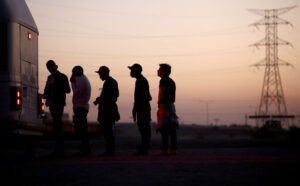Brampton, Ontario, situated in the sprawling outer suburbs of the Greater Toronto Area, is in many ways your typical Canadian city: rows and rows of middle-class houses with verdant lawns line quiet streets, with strip-mall parking lots and big-box stores in between. That it has been for years a majority non-white city, with South Asians accounting for over half the population, speaks to the success of Canada’s classical immigration regime. For even as Brampton grew more ethnically diverse, its orderly if monotonous suburban social template remained the same, attesting to the motto of late Ontario Tory premier and Brampton legend Bill Davis: bland works.
Lately, however, another set of immigration policy trendlines have begun to alter the town’s pacific character. Demonstrations consisting of more recent arrivals, also from South Asia, can now be seen in Brampton, protesting the prospect of their deportation. Though they came to Canada either with temporary worker or student visas, they believe themselves entitled to permanent residency; some of these students are even protesting their own failing grades! That their presence in the country — amounting to a mind-boggling 2.8 million temporary residents in a population of 40-odd million — continues to exert distortionary effects on wages and housing seems not to bother the rally-goers.
Meanwhile, authorities have registered a 30% rise in hate crimes, a 187% increase in auto theft, and a staggering 350% rise in home invasions in the Peel region of which Brampton is part; this has come on the heels of last year’s interethnic tensions, following the slaying of a Sikh activist. These statistics are not to suggest that all crime stems from immigrants but rather that an environment of material scarcity and institutional breakdown conduces to higher rates of crime, whether committed by immigrants or native-born individuals.
In other words, Brampton, a microcosm for Canadian society, has begun to move away from the “bland” Bill Davis country of yesteryear, looking everyday a bit more like those politically fraught immigrant ghettoes found elsewhere; and its condition brings to mind another kind of Tory politician: Enoch Powell. Though Powell, of course, lived in another time and another country, his legacy had been to mark the passage of immigration from a point of quiet consensus into a source of intractable polarisation and social fragmentation. With more Canadians now expressing opposition to immigration, Canada faces its own “Enoch Powell moment”. And as the rest of the West reckons with the consequences of permissive migration, we must ask: how did Canada, so long a liberal multicultural oasis, begin to lose its exceptional status? To answer this, we must first understand the standards of the pre-existing immigration system, from which the current policies have so radically deviated.
Since the Sixties, Canadian immigration has operated on a principle of prudent control, both in terms of quality and quantity. In 1967, Ottawa came up with perhaps the greatest policy innovation that Canada ever produced: the points system, which could be used to measure candidates’ suitability for contributing economically and integrating socially in Canada.
At the same time, the nations of Western Europe, including Britain, were importing migrants from post-colonial peripheries to act as a “lumpenproletariat” or reserve army of labour, leading to a general erosion of social trust. Unlike in Canada where multiculturalism worked as a rhetorical gloss, European societies could not adjust so easily to their new situation, and it is in this context that Enoch Powell gave his infamous “Rivers of Blood” speech in 1968, a divisive act that nonetheless served as an expression of the sense of alarm felt by many ordinary people.
Canada avoided this path — and not just because of its isolated geography. Its leaders consciously opted for a different approach, choosing to prioritise Canadians’ cohesion and security. As the demographics of post-Sixties immigration show, the points system does not discriminate on the basis of race. But it does discriminate in favour of a certain type of immigrant: English or French-speaking, skilled, educated, financially secure, upwardly mobile, entrepreneurial, and so forth, drawn from the middle classes of many nations. This is borne out by positive immigrant performance in such metrics as social mobility, savings accumulation, skills and educational achievement, and overall economic independence.
Thus, Canada is formally multicultural but functionally unicultural. The prevailing leitkultur is not ethnic or racial but rather sociological and class-based.
It was Max Weber who made the connection between the austere theology of Calvinism and the ascendancy of the middle classes of industrialising Europe. At comparable stages of development, it is no surprise that something like Calvinism infuses the outlook of the middle classes of the developing world today, whatever their actual religion. It is an acquisitive (yet ascetic) classically bourgeois disposition that strives for success and respectability while retaining a commitment to family, community, and social order. This is what the points system draws from: it works to pre-empt Powell-esque backlashes by ensuring the quantity of immigration can be adjusted to economic conditions, while the quality is such that new arrivals reinforce the stabilising egalitarian character of society.
Until recently, parties cooperated to maintain this consensus, before a sea change unfolded around the time of Canada’s emergence from Covid-19, which had brought immigration to a standstill. The post-pandemic economy witnessed upward pressure on wages from tight labour markets and downward pressures on rental prices as well as the cratering of international student tuitions: businesses, landlords, and the higher education sector all stood to profit less. And as governments are more likely to respond to the concerns of these groups, policymakers rushed to restore a profitable climate for them. This meant one thing: jacking up the immigration intake.
Alongside immigration targets of more than 2 million new permanent residents until 2025/26 came a still more senseless move: the lifting of restraints on both the hiring of foreign workers and enrolment of international students; notably, these latter temporary streams did not have to pass through the points system to come to Canada, being let in with ever more liberality. The fact that federal Liberals under Trudeau and Ontario Tories under Doug Ford seemed to be of one mind on this only underscored how this arrangement — a betrayal of the previous, pro-middle-class system — had become the new consensus.
Even more damaging than the economic stress are the long-term social implications of having imported a new “lumpenproletariat”. Unlike the “Calvinist” middle-class immigrants of previous cohorts, these ones have often been taken en masse in from the villages and rural regions of their home countries, where lifestyles are markedly “pre-Calvinist”.
Canadian media, for predictable reasons, have been reluctant to report on just how problematic and maladaptive many in these cohorts have been, so journalistic accounts are scarce. But I have it on good authority from sources in the government, educational, and NGO sectors that many of these migrants are failing at most cultural markers of integration: from rampant cheating to disregard of basic norms to glaring lack of linguistic ability to a brazen willingness to bend public policies at every turn. If these trends continue, it won’t be long before places like Brampton acquire toxic reputations akin to the cultural powder kegs of Europe: the banlieus of Paris or the no-go zones of Malmö.
Beyond cuts to future intake across all streams, there can be only one sure way to restore balance to the system, so that it becomes bland again; and that is a sustained and far-reaching campaign of deportation of visa overstays.
But how can this be done?
It’s important first to note that the status quo in Canada is not open borders, even though the effect is similar. It is still a highly regulated and bureaucratised process that’s heavily reliant on visas, permits, and hiring forms; unlike in the US, where millions can live indefinitely as undocumented immigrants, Canada still has elements of a formidable “bureaucratic wall” and functional equivalents to “E-Verify” that could theoretically keep tab on overstayers. The Canadian government could use the vast array of data at its disposal from this system—bank accounts, employment records, bits of personal information and paper trails—to construct a comprehensive live database of temporary residents and prospective deportees, whose exit from the country can then be confirmed by exit controls.
The only thing missing, of course, is the political will to execute such a programme, for no major party seems to be really interested. Even if Canadians do go to an early election after this week’s political shake-up, it is unlikely that it will be fought over this issue. After decades of stability, Canada’s ruling class has chosen to squander its inheritance of the world’s most envied immigration policy. And as for what happens next, whether Canada ultimately goes the way of Bill Davis or Enoch Powell, we need only look to Brampton.
Disclaimer
Some of the posts we share are controversial and we do not necessarily agree with them in the whole extend. Sometimes we agree with the content or part of it but we do not agree with the narration or language. Nevertheless we find them somehow interesting, valuable and/or informative or we share them, because we strongly believe in freedom of speech, free press and journalism. We strongly encourage you to have a critical approach to all the content, do your own research and analysis to build your own opinion.
We would be glad to have your feedback.
Source: UnHerd Read the original article here: https://unherd.com/



